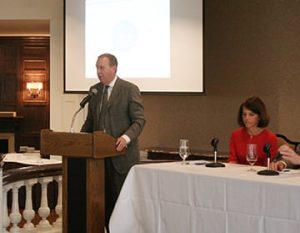We had a wonderful time on Tuesday, November 10, celebrating 15 years of nonprofit fundraising success with more than 120 guests and exploring the role of donor-advised funds (DAFs) in the powerful future of philanthropy. Joined by featured speakers Matt Nash, Senior Vice President of Marketing and Client Experience at Fidelity Charitable and Debbie Wilkerson, President and CEO of the Greater Kansas City Community Foundation, we thoroughly enjoyed the opportunity to share our insight on the impact DAFs can have on our communities and those we serve.
In a series of presentations, Jeffrey, Matt and Debbie “unshrouded” some of the mystery surrounding DAFs by explaining the dynamics of donor and fund relations, the benefits to donors who use DAFs and the continued need for donor stewardship.
To review the most recent research on DAFs, Matt shared data provided by the National Philanthropic Trust’s most recent 2014 report:
- There are an estimated 238,293 DAFs in the U.S. (an 8.8% increase over 2013)
- DAFs outnumber foundations 3:1, and that number is continuing to increase every year
- Total granting from DAFs was $12.5 billion, a 27% increase over 2013 (compared to total U.S. giving (according to Giving USA 2014 data) which increased 7.1% over 2013)
The panel then dug deeper to explore the stimulus behind DAFs and the rationale of fund donors to help us better understand this growing trend. To examine why donors are choosing this giving vehicle, Matt shared information supplied by Fidelity Charitable donors that revealed their motivations:
- 76% select DAFs for growth of charitable assets
- 69% select DAFs to better organize and keep a record of giving
- 68% select DAFs to give them more time to decide where to give
- 90% select DAFs to realize an immediate tax deduction for charitable giving
- 76% select DAFs to donate appreciated assets (non-cash) such as publicly traded stock
Additionally, Matt further explained how investment growth in DAFs drives an increase in funds available for charitable grants, allowing donors to increase their giving capacity:
- Since 1991, investment options at Fidelity Charitable have generated an additional $3.6 billion available for grant making
- Over the last 10 years, dollars granted to charities have tripled
- most contributions are granted out to charities within 10 years
Matt and Debbie both emphasized the strategic nature of donors who give to DAFs in seeking to maximize the benefits of giving—for both financial and charitable planning reasons. They were able to marry the significant statistics visible on both local and national levels by identifying commonalities of the donors and DAFs between their two entities—including comparable median giving account balance, average grant size and the prevalence of non-cash assets being donated to funds.
To give life to these numbers, Debbie shared several examples of local Kansas City area individuals and families who choose to give through charitable giving accounts (DAFs) at the Foundation. She explained how these vehicles enable donors to not only set aside funds specifically designated for long-term charitable giving, but can also be utilized as an educational tool in helping young family members learn about philanthropy and as a resource in exploring new opportunities for giving within the community.
Debbie shared videos profiling three Foundation donors, in which they shared their stories about how and why they utilize DAFs. Their testimonials emphasized how giving funds can be “…a great resource, not only for people who want to give back and might not know the most efficient or most effective way of doing it, but also for those organizations that might not have the right exposure, but the right mission….”
To wrap up the panel’s presentations, Jeffrey discussed how despite the changing landscape of philanthropic giving—as Debbie and Matt affirmed—the majority of DAF donors are not anonymous. He emphasized how critical it is for nonprofits to understand DAFs, remain aware of data and trends and learn how to make this giving vehicle part of their fundraising efforts.
For both donors and organizations to fully benefit from the powerful capacity of DAFs, Jeffrey stressed focusing efforts in three areas:
1. Creating a culture for investment.
The movement happening in local and federal government will affect what we do in daily practice. We need to carefully follow these happenings and advocate for policy that supports a culture of long-term giving.
2. Providing donors with options.
By offering different mechanisms or vehicles for giving, we can encourage charitable giving and facilitate the process in a way that is comfortable for donors. We especially need to capitalize on new technologies that enable maximum giving potential such as the giving widget, which encourages giving on a nonprofit’s website through a donor-advised fund.
3. Continuing to tell our stories.
As DAFs grow in popularity, we must remember that behind these giving vehicles, there are people. In fact, 92% of DAFs are not anonymous, so we must engage these stakeholders by sharing stories of all the good works nonprofits do.
JB+A would like to thank Matt Nash and Debbie Wilkerson for joining us and sharing their insight and experience with our guests.
All of us at JB+A feel privileged to have used this milestone to say thank you to the volunteers, the advocates, the philanthropists and the nonprofit professionals, who continue to give their time, energy and resources to strengthen our communities, and to celebrate what we have achieved together for the betterment of the Greater Kansas City community and communities across the U.S.
To learn more about donor-advised funds, click here.

